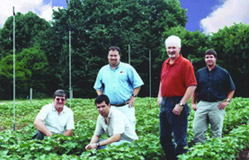Farming with Precision
By: Jamie Creamer

Researchers, from the left, Randy Raper, Jose Terra,
Joey Shaw, Wes Wood & Kip Balkcom are assessing conservation tillage & precision agriculture in a multifaceted study at the E.V. Smith Research Center.
On 20 acres of cropland at the E.V. Smith Research Center in Shorter, AAES researchers and U.S. Department of Agriculture (USDA)scientists have teamed up on a long-term multifaceted field-scale study aimed at helping Alabama's row-crop farmers cut production costs, boost yields, reduce environmental pressures and ultimately remain competitive in the world marketplace
Using the space-age technologies of precision agriculture, the researchers are investigating how different crop management practices–including tillage systems, crop rotations, cover crops and soil fertility treatments–across the highly variable soil types and landscapes in a field interact to impact soil quality and crop yields, as well as greenhouse gas emissions.
And in the process, they're collecting extensive data that growers in the Southeast can use to determine whether the substantial capital outlay that's required for switching from conventional farming to precision, or "site-specific," agriculture is a cost-effective investment for their farming operations.
"Economics drives everything, and things are tight and getting tighter for farmers," says Randy Raper, agricultural engineer with USDA's Agricultural Research Service (ARS) National Soil Dynamics Laboratory on the AU campus. "Farmers know their fields, and they can tell you where the trouble spots are, but just knowing it isn't enough anymore. Now, if an area of the field isn't producing, they have to say, ‘Why isn't it producing, and how do I fix it?'"
Joey Shaw, CoAg soil scientist and research team member, agrees with Raper and says for Alabama farmers, better management is a key to survival, and precision agriculture can result in better management.
"Within southeastern Coastal Plain fields, it's a given that you have variability in the soils and topography, and that these variables affect crop production," Shaw says.
"Traditionally, we've managed our cropland based on the average soil condition and treated the entire field as a single unit. This is sometimes inefficient, because you'll overapply in some areas and underapply in others."
In the fall of 2000 Shaw and Raper, along with ARS agronomist Wayne Reeves, CoAg precision agriculture specialist Paul Mask and Jim Bannon, director of AAES outlying units, established the cooperative AAES/ARS study in an E.V. Smith field that previously had been managed under conventional farming methods.
The researchers converted the cropland to a cotton/corn rotation, and for almost four years have been farming half of the acreage using conventional tillage practices–no cover crops and extensive plowing and disking–and half using conservation tillage practices, including high-residue cover crops and surface tillage with in-row subsoiling. In addition, they are comparing whether inorganic fertilizers or dairy manure from the E.V. Smith dairy have an impact on production in either or both systems.
Through the project's first three years, yield monitors–devices that are mounted to harvesting equipment to measure crop yield and field position during harvesting– showed that acreage farmed with conservation tillage had significantly higher yields than the conventional system, producing cotton yields that were 12 percent higher than conventional in 2001, 24 percent in 2002 and 14 percent in 2003. Jose Terra, a CoAg graduate student in agronomy who collected and analyzed data from those three years, says data suggest the higher soil moisture content resulting from cover crop residue in the conservation system was a key contributor to the increased yields.
According to the researchers, this is the first study in the region to look at crop management systems, productivity and landscape interactions.
"In the past, a test like this would have been conducted on 25-foot test plots," Shaw says. "This is one of the first studies in the region to evaluate crop management systems that traverse an entire field, with all of its variability."
The detailed information this project has provided and will continue to provide in the years ahead would not have been possible without the advent over the past decade of precision farming and the technology it utilizes–including geographical information systems (GIS), global positioning systems (GPS), remote sensors, variable rate technologies, yield monitors and auto-steer farm machinery.
"Precision technology is a great management tool because it takes us from estimations of field conditions and yields to specific numbers and exact locations," Reeves says. "Producers have got to be able to get precise information they can use to make the best decisions on how to better manage farm inputs like fertilizers, herbicides and water."
Without question, Raper says, producers who are in farming for the long haul must consider adopting precision technology to reduce production costs and increase farm income.
"In a way, the technology is ahead of theory on precision agriculture," says ARS agronomist Kip Balkcom, newest member of the research team. "I see our role as independently evaluating all the technologies to show which are the best investment, which will pay in the long run."
Researchers hope the project will continue for years and serve as a springboard for other studies. Says Shaw, "Now that this project is established, we have endless possibilities for developing other research projects."
The first example of that occurred this past spring, when AAES researcher Wes Wood, CoAg professor of environmental soil science, secured an AAES grant to piggyback on the field-scale study to determine the complex issue of whether cropping systems and landscape/soil variability affect emissions of three so-called greenhouses gases–carbon dioxide, methane and nitrous oxide–in soils.
"This will give us a better understanding of how agriculture impacts global warming and help equip farmers to respond to environmental regulations that may be handed down in the future," says Wood.
Producers interested in learning more about the study and its findings can contact Shaw at 334-844-3957 or Raper at 344-844-4654.
